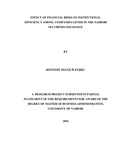| dc.contributor.author | Wanjiku, Kennedy, N | |
| dc.date.accessioned | 2017-01-04T13:01:35Z | |
| dc.date.available | 2017-01-04T13:01:35Z | |
| dc.date.issued | 2016 | |
| dc.identifier.uri | http://hdl.handle.net/11295/98907 | |
| dc.description.abstract | The growth and development of the financial institutions are dependent on the effective and efficient management of its risks and opportunities. The search for precise tools to measure and manage the risk is an on-going process, which indicates that sufficient models and theories have not yet been made. Since the last financial crisis, there has been more pressure for regulation towards risk management at financial companies worldwide in order to decrease the consequences of a future crisis. The fact that most companies listed in the Nairobi Securities Exchange operate within a defined common bond exposes them to a relatively high degree of financial risks compared to corporate firms. Indeed many companies listed in the Nairobi Securities Exchange have in the past experienced some crisis in their operations and sustainability as a result of lack of risk identification and management mechanisms. Despite the well-established literature on the conventional financial institutions, studies on the relationship between financial risk management and efficiency of the firm remain scanty. The purpose of this study was to determine the effect of financial risks on institutional efficiency among companies listed in the Nairobi Securities Exchange. This study applied descriptive research design. Data was collected from all the 63 companies listed at the Nairobi securities exchange. Secondary data was used in this study for the last 5 years starting year 2011 to 2015. Quantitative analysis was used through descriptive statistics. In addition, a multivariate regression model was applied to determine the effect of financial risks on institutional efficiency. Categorical Data Envelopment Analysis (DEA) was used to measure institutional efficiency of the companies listed in the NSE. The study found that foreign currency contribute most to the institutional efficiency followed by interest rate risk, then credit risk while liquidity risk had the least effect on institutional efficiency among companies listed in Nairobi Securities Exchange. Due to the importance of foreign currency in the investment decisions, care should be exercised in determining the correct and comparable foreign currency of each company. Strategies to facilitate a favorable financial risks management at the NSE companies should be adopted by management for a good institutional efficiency. The government as companies regulator through the CMA should adopt policies that ensure increased efficiency among NSE listed companies. Strict conditions of minimum liquidity and capital should continue being emphasized on to ensure none of the companies have lower of the two. | en_US |
| dc.language.iso | en | en_US |
| dc.publisher | University of Nairobi | en_US |
| dc.rights | Attribution-NonCommercial-NoDerivs 3.0 United States | * |
| dc.rights.uri | http://creativecommons.org/licenses/by-nc-nd/3.0/us/ | * |
| dc.subject | Effect of Financial Risks on Institutional Efficiency Among Companies | en_US |
| dc.title | Effect of Financial Risks on Institutional Efficiency Among Companies Listed in the Nairobi Securities Exchange | en_US |
| dc.type | Thesis | en_US |



